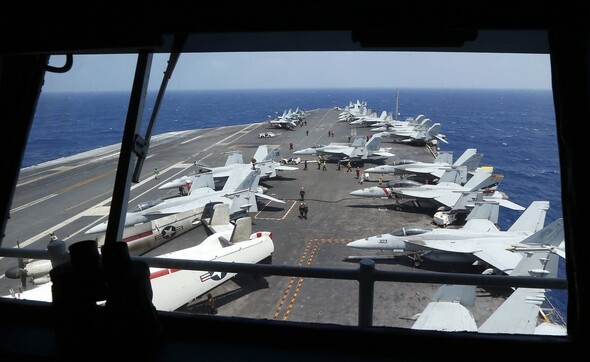hankyoreh
Links to other country sites 다른 나라 사이트 링크
[Editorial] Redeployment of tactical nuclear weapons is not a solution to N. Korean nuke issue

In its efforts to develop new North Korea policy, the Donald Trump administration in the US is reportedly weighing the option of redeploying tactical nuclear weapons on the Korean Peninsula. There’s even been talk of a preemptive strike on the North, a secondary boycott against China, and additional THAAD system deployments on the Korean Peninsula. A new government is entitled to consider every option as it forms its policy, but it’s worrying to see how much of its focus is on hard-line options that are unrealistic and create serious side effects.
Tactical weapons, or small-scale nuclear weapons, were deployed with US Forces Korea for decades before being removed completely in 1991. This is what led to then-US President George H. W. Bush’s nuclear disarmament declaration and South and North Korea’s agreement on a declaration for the denuclearization of the Korean Peninsula. North Korea’s nuclear development program flies in the face of that denuclearization declaration. Redeployment of tactical nuclear weapons is not a solution, since it would legitimize North Korea’s nuclear development and encourage a nuclear arms race. Yet what lie beneath the arguments for redeployment from some South Korean and US hard-liners is the assumption that the nuclear issue is unresolvable. Their aim is to replace efforts to solve that issue with a “balance of terror.”
Calls for a preemptive strike amount to a plan for war and have nothing to do with any resolution to the nuclear issue. Not only does the very idea of a preemptive strike rest on the assumption of an imminent North Korean attack, but it would be impossible to hit all of its nuclear facilities at once. It‘s also arbitrary to claim that the preemptive strike calls and tactical nuke redeployment would have an effect in sending Pyongyang a powerful warning. It’s more likely to lead to more provocations from the North and make the situation worse. The secondary boycott calls, which are a beefed-up form of the existing calls for a greater role from Beijing in resolving the nuclear issue, are likely to only intensify US-China antagonisms, leaving Pyongyang in an even stronger position. They’re also an attempt to make Beijing shoulder all the effort in addressing the nuclear issue.
All the different hard-line arguments coming from Washington have something in common: they emphasize brute force instead of finding an effective alternative. They’re also not much different in their aims from the Barack Obama administration’s “strategic patience” policy. The Trump administration is only getting more inflexible in the means it’s discussing. North Korea has cited its nuclear program as the reason for the hostile policies from the US. If Washington were to join forces with other countries involved in Korean Peninsula issues and pursue sincere negotiations with Pyongyang, we could see some very different developments on the nuclear issue. There’s no need for the Trump administration to let itself get hamstrung by its predecessors’ failures.
The South Korean government, for its part, need to show its diplomatic skills to help establish a framework for negotiations toward resolving the nuclear issue. There‘s nothing to be gained in terms of boosting security or solving the nuclear problem from harsh rhetoric and hitching its wagon to untenable hard-line positions.
Please direct questions or comments to [english@hani.co.kr]

Editorial・opinion
![[Guest essay] The real reason Korea’s new right wants to dub Rhee a founding father [Guest essay] The real reason Korea’s new right wants to dub Rhee a founding father](https://flexible.img.hani.co.kr/flexible/normal/500/300/imgdb/original/2024/0423/8317138574257878.jpg) [Guest essay] The real reason Korea’s new right wants to dub Rhee a founding father
[Guest essay] The real reason Korea’s new right wants to dub Rhee a founding father![[Column] ‘Choson’: Is it time we start referring to N. Korea in its own terms? [Column] ‘Choson’: Is it time we start referring to N. Korea in its own terms?](https://flexible.img.hani.co.kr/flexible/normal/500/300/imgdb/original/2024/0423/3617138579390322.jpg) [Column] ‘Choson’: Is it time we start referring to N. Korea in its own terms?
[Column] ‘Choson’: Is it time we start referring to N. Korea in its own terms?- [Editorial] Japan’s rewriting of history with Korea has gone too far
- [Column] The president’s questionable capacity for dialogue
- [Column] Are chaebol firms just pizza pies for families to divvy up as they please?
- [Column] Has Korea, too, crossed the Rubicon on China?
- [Correspondent’s column] In Japan’s alliance with US, echoes of its past alliances with UK
- [Editorial] Does Yoon think the Korean public is wrong?
- [Editorial] As it bolsters its alliance with US, Japan must be accountable for past
- [Guest essay] Amending the Constitution is Yoon’s key to leaving office in public’s good graces
Most viewed articles
- 1[Guest essay] The real reason Korea’s new right wants to dub Rhee a founding father
- 2Senior doctors cut hours, prepare to resign as government refuses to scrap medical reform plan
- 3[Column] ‘Choson’: Is it time we start referring to N. Korea in its own terms?
- 4Why Korea shouldn’t welcome Japan’s newly beefed up defense cooperation with US
- 5Terry Anderson, AP reporter who informed world of massacre in Gwangju, dies at 76
- 6New AI-based translation tools make their way into everyday life in Korea
- 7[Column] The clock is ticking for Korea’s first lady
- 8Opposition calls Yoon’s chief of staff appointment a ‘slap in the face’
- 9[Editorial] Japan’s rewriting of history with Korea has gone too far
- 10Korean government’s compromise plan for medical reform swiftly rejected by doctors